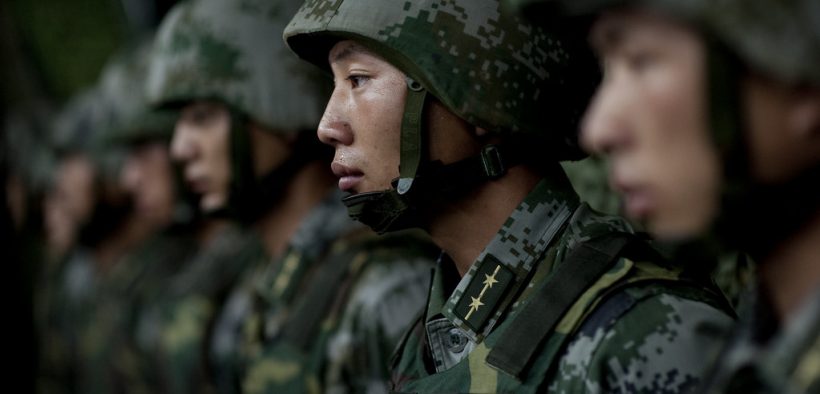Pentagon Report Forecasts an Array of Chinese Military Bases Around the World

“With few overt military preparations beyond routine training, China could launch an invasion of small Taiwan-held islands in the South China Sea such as Pratas or Itu Aba.”
The Pentagon said in an official report released on Thursday that China would build a string of military bases around the world to protect its ambitious global infrastructure project: One Belt, One Road (OBOR) or the Belt and Road Initiative (BRI).
Currently, Bejing has only one military base abroad which is in the small Eastern African country of Djibouti. The Pentagon is convinced that Beijing is planning to add more, including one in Pakistan.
“China will seek to establish additional military bases in countries with which it has a longstanding friendly relationship and similar strategic interests, such as Pakistan,” the report added.
China’s investment in its OBOR initiative may propel the mainland to set up military bases overseas to provide a security guarantee for OBOR-related projects, explained the Pentagon in its annual report. Multiple regions could become home to Chinese military bases including countries in the Middle East, the Western Pacific and Southeast Asia.
The Guardian said the report came out as the Pentagon warned of increased Chinese activities in the Arctic region which could pave the way for a stronger military presence – specifically for the distribution of vessels that can prevent a nuclear attack.
China has set up armed posts in the disputed South China Sea. Last year, a report suggested there was a discussion of a Chinese military base in the Wakhan corridor, northwest of Afghanistan.
Additionally, the Washington Post has recently identified a post occupied by many Chinese troops in East Tajikistan, near the strategic intersection of the Wakhan Corridor, Pakistan and China.
Pentagon Discusses Possibility of Chinese Invasion of Taiwan
The Pentagon report also discussed Taiwan, a country China dubs as a renegade province. On January 2, President Xi Jinping said in his speech that China has the right to exercise its power to bring Taiwan under mainland control, but it will try to pursue “a peaceful re-integration.”
The Pentagon report described some potential scenarios Beijing could follow if it decides to exercise its military power over Taiwan – including a comprehensive campaign specially designed to coerce Taiwan to surrender to either a unification dialogue or unification altogether.
However, the report also warned of the risks China would endure if it were to invade Taiwan. “An attempt to invade Taiwan would likely strain China’s armed forces and invite international intervention,” the report detailed.
China and the US: Comparing Military’s Capabilities
According to a report from the Stockholm International Peace Research Institute (SIPRI) released last week, the U.S. and China together accounted for half of all global military spending in 2018.
The Pentagon’s report explained that Beijing’s armed forces were growing at a fast rate and could pose a threat to U.S. military dominance.
How strong is China’s defense capability compared to that of the U.S? Military comparison according to armedforces.eu:
- Land: The U.S. has 6,393 tanks, 41,760 armored fighting vehicles, 3,269 total artillery, 950 self-propelled artillery and 1,197 rocket artillery. China has 7,760 tanks, 6,000 armored fighting vehicles, 9,726 total artillery, 1,710 self–propelled artillery and 1,770 rocket artillery.
- Air: The U.S. has 12,304 total aircraft, 457 fighter aircraft, 2,191 multirole aircraft, 587 attack aircraft and 4,889 helicopters. China 4,182 total aircraft, 1,150 fighter aircraft, 629 multirole aircraft, 270 attack aircraft and 1,170 helicopters.
- Sea: The U.S. has 437 total naval vessels, 20 aircraft carriers, 85 destroyers and 71 submarines. China has 780 total naval vessels, 2 aircraft carriers, 36 destroyers, 54 frigates, 42 corvettes and 76 submarines.
- Nuclear: The U.S. has 7,200 nuclear warheads while China has 260 nuclear warheads
- Manpower: The U.S. has 1,281,900 active personnel and 811,000 reserve personnel, while China has 2,300,000 active personnel and 8,000,000 reserve personnel.
SIPRI’s report explained that China’s increase in war equipment and defense continues a two-decade trend. In 2018, the mainland spent $250 billion on defense. Regional tensions helped to boost military spending. The increase is China’s 24th consecutive annual increase in military spending.
Will China Invade Taiwan?
China invading Taiwan is unlikely at the moment, said the Pentagon report. China may modernize its military equipment, but China’s military does not have an adequate capacity to seize Taiwan and involve a full-scale blockade.
The report explained a full-scale amphibious invasion is a difficult and complex operation where success relies on the superiority of a country’s navy and air force.
China, the report said, still needs more wheeled-armored vehicles to do a full-scale operation. However, a small-sized invasion in the contested South China Sea could be a possibility should any military action take place.
“With few overt military preparations beyond routine training, China could launch an invasion of small Taiwan-held islands in the South China Sea such as Pratas or Itu Aba. A PLA invasion of a medium-sized, better-defended island such as Matsu or Jinmen is within China’s capabilities. Such an invasion would demonstrate military capability and political resolve while achieving tangible territorial gain and simultaneously showing some measure of restraint,” the report explained.















